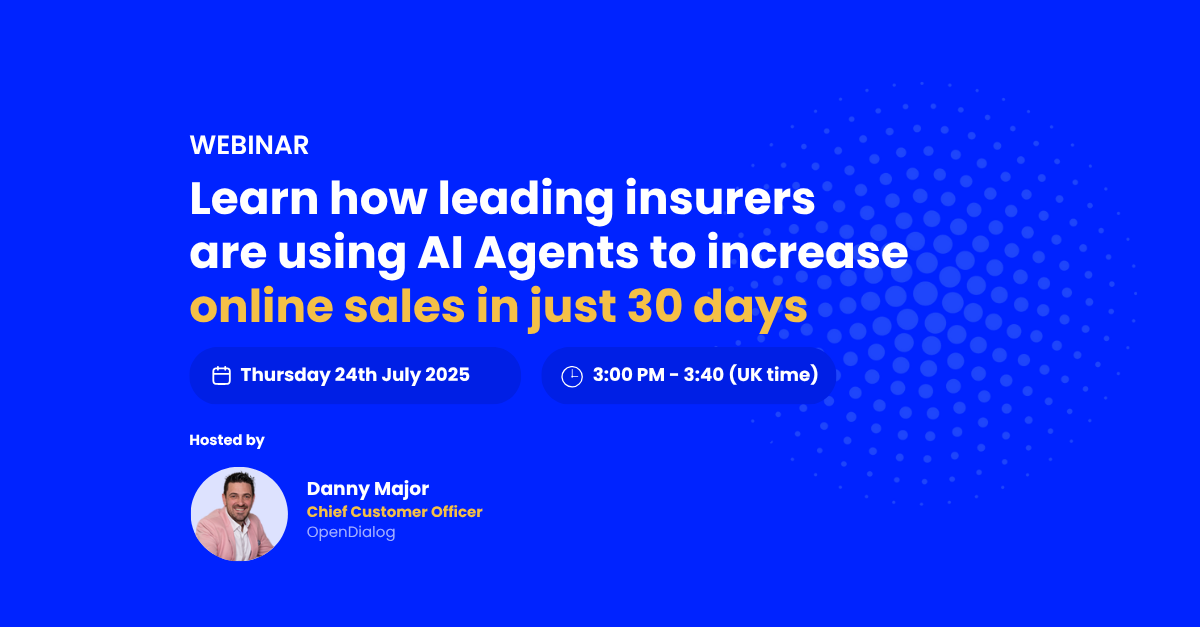What do you associate with healthcare services? Long wait times, frustrating patient experience, and feeling lost? It doesn’t have to be this way – for you, or your patients.
Healthcare is undergoing a revolution, and conversational AI is at the forefront. The integration of artificial intelligence with automation is opening up new possibilities for improving patient care, streamlining processes, and enhancing overall healthcare experiences. In fact, artificial intelligence in the healthcare market was valued at 16.3 billion USD in 2022, and is expected to grow 40.2% to reach 173.55 billion USD by 2029.
What is Conversational AI?
Conversational Artificial Intelligence, or conversational AI, refers to the use of AI technologies such as natural language processing (NLP), machine learning, and large language models (LLMs) that enable machines to understand, interpret, and respond to human language in a conversational manner. Examples of this include the generative AI chatbot, ChatGPT, that took the world by storm, and enterprise-grade conversational AI platforms like OpenDialog. If you’d like to delve into more detail about how it works and understand its relationship to generative AI, check out our guide to conversational AI.
How can Healthcare Companies use AI?
As a healthcare executive, you may be wondering why, or how, you can actually use generative AI. The why is simple: it will improve the lives of patients and staff enormously, all while actually increasing productivity and saving your organization money.
Strain on staff and hiring challenges are well documented across all facets of the healthcare sector. Combining AI and automation increases efficiency and allows healthcare professionals to focus on more complex and personalized patient interactions, improving both the quality of care and the overall experience for everyone.
You can leverage conversational AI across multiple stages of your operations to enhance patient care, improve processes, and streamline spending. For example, AI chatbots can be used for assisting patients with prescriptions, advice, and test results.
According to Sequence Health, “care team members spend 1.5 to 2 hours a day on the phone calling patients”. This is where conversational AI comes in to allow providers to repurpose the time and focus on more important patient care activities.
The Benefits of Using Conversational AI in Healthcare
- Enhanced patient engagement
- 24/7 accessibility
- Improved appointment management
- Efficient triage and resource allocation
- Cost savings
- Remote patient monitoring
- Language accessibility
- Patient empowerment through education
- Efficient data handling and analysis
The best ways to use conversational AI in healthcare
There are so many ways to use conversational AI in healthcare, it can be difficult to know where to start. To help you understand what’s possible, and how the technology can solve challenges within your organization, we’ve put together this list of some of the best use cases for conversational AI in healthcare:
1. Intercepting calls and answering FAQs
For many healthcare services, the best place to start with conversational AI is to use digital assistants to alleviate the workload of overburdened staff by answering frequently asked questions. This, in turn, improves overall patient experience by reducing call wait times and dropped calls, which could otherwise have serious consequences.
AI assistants can be used to manage call redirection to correct health professionals and handle calls that don’t necessarily require immediate human interaction, either through voice assistants or by deflecting them to digital channels for a better experience.
Today, conversational AI digital assistants, like OpenDialog, can successfully automate up to 90% of interactions currently handled by contact centers and front office support desks. Using conversational AI in this way ensures people get the help that they need in a fraction of the time and frees up healthcare professionals to assist those with more urgent or complex needs.
Business outcome: Improve efficiency, patient safety, and reduce operating costs.
2. Appointment Scheduling and Reminders
Missed appointments are costly for healthcare providers. They waste time for staff and lengthen wait times for other patients. Automating reminders for patients and removing friction from managing their appointments are both proven ways to drastically reduce the number of ‘Did Not Attends’.
Furthermore, implementing an AI-powered digital agent to handle appointment scheduling and reminders greatly reduces the administrative workload on hospitals and healthcare facilities and frees up phone lines for patients who need to speak with a human.
Business outcome: This not only reduces the administrative burden, saves money and ensures a better patient experience, it also greatly increases efficiency which can improve patient safety.
3. Patient Triage and Symptom Checker
The global virtual assistance market in healthcare is expected to grow 15.6% from 2022 to 2031, as an increasing number of healthcare facilities adopt AI to manage growing patient demand.
The primary goal of triage is to ensure that the most critical cases receive attention and resources first. Virtual health assistants can help with this by assessing patient symptoms through natural language conversations, offering initial triage and guidance.
Business outcome: This helps in prioritizing cases, offering immediate assistance to those in urgent need, and reducing unnecessary visits to healthcare facilities.
4. Medication Management and Adherence
Adherence to prescribed treatment plans is critical for ensuring good clinical outcomes for patients. However, many patients struggle to keep up with or can become confused about when and which drugs to take each day.
Conversational AI can assist patients in managing their medication schedules by providing reminders, offering information about dosage, and answering questions related to medications. Meanwhile, doctors can monitor how well plans are adhered to and intervene if required.
Business outcome: Promotes better adherence and contributes to patient safety and improved health outcomes.
5. Post-Discharge Follow-Up
To healthcare professionals, it’s no secret that a swift and successful post-discharge follow up for patients reduces the risk of readmission. But often, healthcare resources just aren’t there to follow up.
Conversational AI can facilitate automated follow-up conversations, monitoring patient progress, and addressing any concerns or questions they may have after leaving the healthcare facility, at any time of day or night.
Business outcome: Time and cost effective automated follow ups, in place of eating into doctors’ and administrators’ time.
6. Remote Patient Monitoring
Remote patient monitoring utilizes technology to collect and transmit patient health data, enabling healthcare providers to monitor conditions remotely. Its main purpose is to improve patient care through real-time data, early issue detection, and increased patient engagement, ultimately reducing hospitalizations and enhancing overall healthcare outcomes.
Conversational AI can facilitate remote patient monitoring by enabling natural language interactions between patients and virtual assistants, allowing for seamless reporting of health data and providing timely feedback. This enhances communication, streamlines data collection, and contributes to a more personalized and responsive healthcare experience.
Business outcome: Accurate, centralized monitoring, that lowers operational costs.
7. Health Education and Information Dissemination
It is said that good doctors can help unlock another carer within their patients, through empowering them to look after themselves and use preventative approaches. This is another way conversational AI virtual assistants are revolutionizing the healthcare industry.
Virtual health assistants can deliver personalized health education content, promoting preventive care and lifestyle changes. They can also disseminate information about diseases, treatments, and wellness programs, empowering patients to take an active role in their healthcare.
Business outcome: Increasing patient education and trust improves their perception of the healthcare provider.
8. Medical Information on Pharmaceuticals
Medical information is crucial for healthcare professionals as it provides the foundation for accurate diagnosis, effective treatment, and informed decision-making in patient care. However, accessing medical information can be challenging due to the sheer volume and complexity of data, fragmented data sources, and the rapid evolution of medical knowledge.
Using Natural Language Understanding (NLU) to process large amounts of medical information, conversational AI can summarize and provide up to date, accurate and strategic information and advice on all clinical aspects of medicines for the pharmaceutical industry. This can support doctors, nurses, pharmacists and other healthcare professionals in clinical decision making.
Business outcome: Can enhance efficiency and decision-making in healthcare, leading to improved patient care, reduced administrative burden, and increased productivity for medical professionals.
9. Patient Feedback and Experience Surveys
Gathering patient feedback is essential for continuous improvement. Conversational AI can automate the process of collecting feedback and conducting experience surveys, providing valuable insights for healthcare providers to enhance their services.
One of the benefits of collecting feedback via conversational AI, as opposed to a form, is that through the conversation, the digital agent can ask relevant follow up questions to gain deeper insight or clarification on the patient’s responses. This leads to better qualitative data insights for the healthcare service to use.
Business outcome: Create a high-quality patient experience, tailored to their feedback, improving care and satisfaction.
10. Mental Health Support and Wellbeing
Conversational AI can be a valuable tool in addressing the growing concerns around mental health. Virtual mental health assistants can engage in empathetic conversations, providing support, resources, and coping strategies.
These AI systems can monitor subtle changes in language and behavior, alerting healthcare professionals to potential mental health issues and enabling timely intervention. This use case not only expands access to mental health resources but also reduces the stigma associated with seeking help.
Business outcome: Offering a unique and highly valuable service to customers.
What’s the common thread between all of these use cases for conversational AI, and their business outcomes, for your healthcare organization? The quality of patient care is improved, and both your staff and patients benefit from increased efficiencies.
Want to learn more about improving healthcare services through generative AI? Download our eBook.




